PORTLAND, Ore — Since the beginning of the COVID-19 pandemic, there has been a lot of discussion around face masks.
As of Wednesday, face coverings are required in seven Oregon counties, in indoor businesses open to the public. In Washington state, face coverings will be mandatory mandatory in public, both indoors and outdoors when it’s impossible to maintain 6 feet of physical distance from others, starting Friday.
The Oregon Health Authority released a statement on Thursday, issuing new guidance for the public when it comes to face masks.
OHA's guidelines include:
- Face coverings are required when riding public transit, unless the individual is under 2 years of age, has a medical condition that makes it hard to breathe when wearing a mask, face shield, or face covering, or has a disability that prevents the individual from wearing a mask, face shield, or face covering
- It is strongly recommended that individuals wear a face mask, face shield, or face covering at all times in all indoor public places, particularly in places where it is likely that physical distancing of at least six feet from other individuals cannot be maintained at all times
- Because children between the ages of 2 and 12 years of age can have challenges wearing a face covering properly, it is urged that they are worn with the assistance and close supervision of an adult. Masks, face shields or face coverings should never be worn by children when sleeping.
- Face coverings may be optional if 6 feet or more of distance is maintained from others
So why is it so important to wear one? Does it actually keep you safe?
The Centers for Disease Control and Prevention, along with other health experts, say that it is possible for the new coronavirus to be spread even by people who are infected, but show no symptoms.
On Wednesday, Oregon Health & Science University released a new evidence review examining the role masks play in containing the spread of COVID-19. Dr. Roger Chou lead the review. He said findings showed that even if wearing masks were only a little effective, that small impact could have a big effect in preventing the spread of COVID-19.
"Even if masks are only modestly effective, it creates a big effect down the road because the virus spreads exponentially," said Chou, director of the Pacific Northwest Evidence-based Research Center at OHSU. "Even a small effect on wearing masks in public could have a big impact on community spread down the road."
The COVID-19 virus is spread through respiratory droplets from infected people, so covering your mouth and nose helps prevent that spread. Therefore, wearing a face mask or face covering helps protect those around you.
To put this visually, Matthew Staymates of the National Institutes of Standards and Technology created a high-speed visualization illustrating air flow when breathing and coughing, with and without different types of homemade face coverings.
Out of his experiments, Staymates and his team came up with a clear message: "Cover smart. Do your part. Slow the spread."
"We learned that even the simplest face coverings (bandannas, ski neck warmers, etc.) stopped much of your cough from landing on someone else," said Staymates in the report. "We also learned that a good seal around the nose, chin and cheeks helps to prevent your cough from 'leaking' out of the covering. And pulling your face covering below your nose is not good — you would be surprised how much air comes out of your nose when you cough."
Another thing he observed was a big reduction in airflow velocity while talking with a face covering on. In the end, Staymates said a breathable mask, using a few layers of tightly-woven fabric, works best.
Once you wear your mask, you should wash it in the washing machine on a daily basis - wash it after each outing. And remember, even with a mask on, you should maintain social distancing. You can still get coronavirus while wearing a mask.

